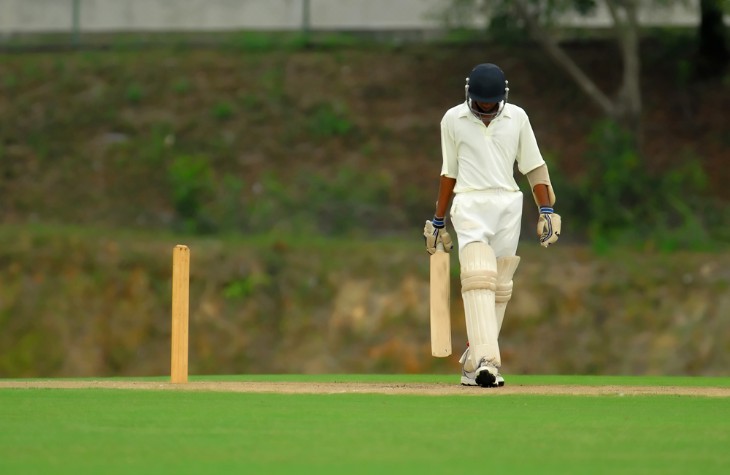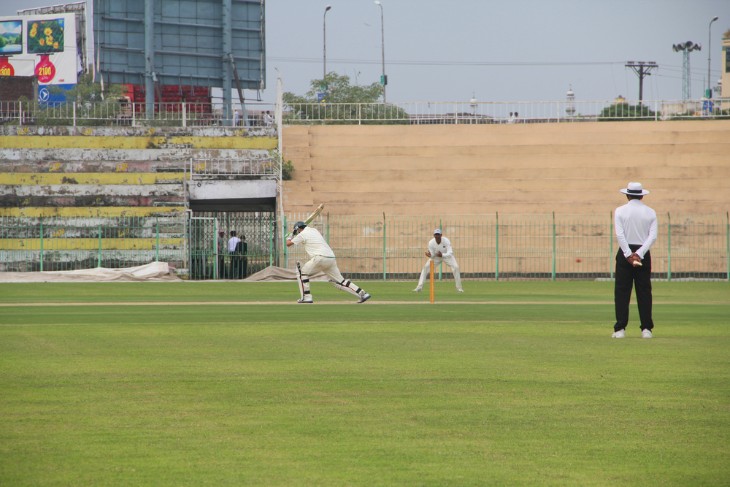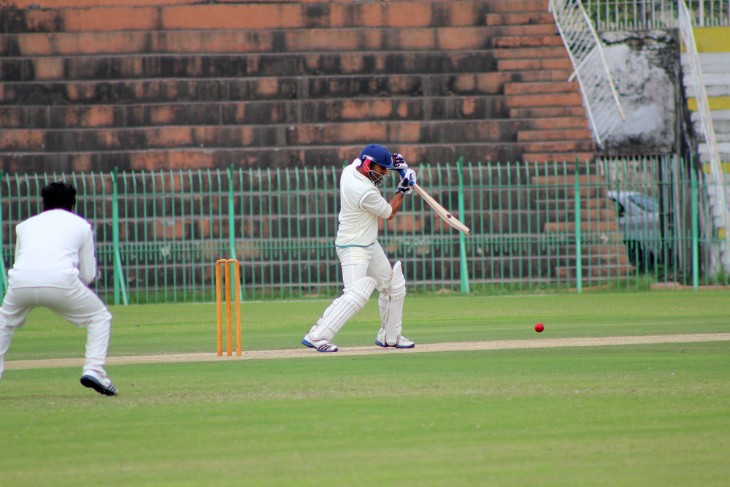In the world of cricket, overs are not just a measure of time; they are the heartbeat of the game. Whether it's the patient strategy of Test cricket, the explosive fireworks of Twenty20s, or the precision tactics of One-Day Internationals (ODIs), the significance of overs varies across formats. These blocks of six deliveries wield the power to shape the fate of matches, prompting captains, bowlers, and batsmen to craft intricate strategies that make cricket one of the most captivating and dynamic sports on the planet. So, in this article, we will try to find a comprehensive answer to the question: What is an over in cricket?
What is an Over in Cricket?
In cricket, an "over" refers to a set of six legal deliveries (bowled by the same bowler) to the batsman at the other end of the pitch. The term "over" is used to measure the number of balls bowled in a cricket match and is a fundamental unit of the game.
During an over, the bowler tries to dismiss the batsman while the batsman attempts to score runs. The bowler's primary objective is to either get the batsman out (by various means such as getting them bowled, caught, or leg before wicket) or to restrict the batsman from scoring too many runs. After six deliveries have been bowled, the over is complete, and another bowler from the fielding side may take over and bowl the next set of six deliveries from the opposite end of the pitch.
Each team has a certain number of overs they can bowl in an inning, which is typically defined before the start of the match. In international matches, for instance, teams are usually allowed 50 overs per inning in One-Day Internationals (ODIs), while in Test matches, there is no set limit on the number of overs, and each team bats until they declare or are all out.
Overs are a critical aspect of cricket strategy, as they determine how many deliveries the bowling side has to dismiss the batting side or restrict their scoring, and they also influence the batsmen's approach to accumulating runs.
Now let’s take a closer look at the concept of an "over" in cricket:
- Six Deliveries: An over consists of a sequence of six deliveries, which are bowled by the same bowler consecutively from one end of the cricket pitch to the batsman at the other end. Each delivery is a chance for the bowler to try and dismiss the batsman or prevent them from scoring runs.
- Measurement of Play: Overs are used to measure the progression of the game. They serve as a standard unit for counting balls bowled and are crucial for determining various aspects of the match, such as how many deliveries remain in an inning and how many overs a bowler has bowled in a spell.
- Objective for the Bowler: The primary objective of the bowler during an over is to take wickets, which means getting the batsman out. This can be achieved through various means:
- Bowled: The bowler hits the stumps, and the bails are dislodged.
- Caught: The batsman hits the ball, and it's caught by a fielder without the ball touching the ground.
- LBW (Leg Before Wicket): The ball would have hit the stumps, but the batsman's leg gets in the way, preventing the ball from hitting the stumps. However, certain conditions must be met for an LBW dismissal.
- Run Out: The fielding side manages to get the batsman out by hitting the stumps with the ball before the batsman can complete a run.
- Restricting Runs: In addition to taking wickets, bowlers also aim to restrict the batsman from scoring runs. They do this by delivering a combination of different types of deliveries, such as fastballs, spin balls, yorkers, and slower balls, to make it challenging for the batsman to play shots.
- Change of Bowler: After an over is completed, another bowler from the fielding side can take over and bowl the next set of six deliveries from the opposite end of the pitch. This rotation of bowlers allows the captain to employ different tactics, exploit pitch conditions, and apply pressure on the batsmen.
- Limited Overs Formats: In limited-overs formats of the game, such as One-Day Internationals (ODIs) and Twenty20 (T20) matches, both teams are allocated a fixed number of overs for their innings. For example, in ODIs, each team typically gets 50 overs to bat, and in T20s, it's usually 20 overs per inning.
- Strategic Importance: Overs play a critical role in cricket strategy. The captain and bowlers must plan how to use their allocated overs effectively, considering factors like the pitch condition, the quality of batsmen, and the target score. Similarly, batsmen need to pace their innings based on the number of overs left in the inning.
- Test Matches: In Test cricket, which is the longest format of the game, there is no limit on the number of overs a team can bowl in an inning. Instead, each team bats until they declare their inning closed or until they are all out.

Strategic Aspects of Overs in Cricket
Now when we know what is an over in cricket, let’s talk about its strategic aspects. Managing overs and formulating effective strategies around them is a dynamic and crucial aspect of cricket. It involves a blend of tactical decisions, understanding the strengths and weaknesses of players, and adapting to the ever-changing dynamics of the game.
Cricket strategy, especially in limited-overs formats like One-Day Internationals (ODIs) and Twenty20 (T20) matches, heavily revolves around how teams manage their overs. Let’s take a look at some of the key aspects of cricket strategy related to overs:
- Opening Bowlers: Typically, a team's best bowlers are chosen as the opening bowlers. They are expected to take early wickets and set the tone for the innings. Their primary focus is on containment and wicket-taking. Captains often try to save a few overs of their best bowlers for the death overs (the final overs of an inning) when batsmen tend to go for big shots.
- Powerplay Overs: In limited-overs cricket, there are usually mandatory powerplay overs at the start of each inning. During the powerplay, only a limited number of fielders are allowed outside the inner circle (the first 30 yards from the batsman). Teams often use this period to attack and score quickly. Bowling strategies during powerplays involve mixing up deliveries to prevent easy scoring opportunities while aiming for wickets.
- Spin Bowling: Spinners can be particularly effective in the middle overs when the ball gets older, and the batsmen are looking to rotate the strike and build partnerships. The slower pace of spinners can make it challenging for batsmen to score boundaries. However, spinners must also be careful not to concede too many singles and rotate the strike.
- Death Overs: The last few overs of an inning, known as the death overs (usually 40-50 in ODIs and 16-20 in T20s), are crucial. Batsmen look to accelerate and score as many runs as possible, while bowlers aim to take wickets and restrict scoring. Fast bowlers with good yorkers and slower-ball variations are often preferred during this phase.
- Rotation of Bowlers: Captains and coaches carefully plan the rotation of bowlers to maximize their effectiveness and exploit batsmen's weaknesses. They may bring in different bowlers to target specific batsmen or adjust to changing pitch conditions.
- All-Rounders: Teams with quality all-rounders can use them strategically. All-rounders can provide batting depth and also contribute with crucial overs. They offer flexibility in team selection and can be used to bridge the gap between specialist bowlers and batsmen.
- Field Placements: Field placements play a critical role in controlling the game. Captains set fields based on the type of bowler, the batsman's strengths and weaknesses, and the stage of the game. For example, in the early overs, fielders may be placed in catching positions to capitalize on the new ball's movement, while in the middle overs, fielders are often spread out to save runs.
- Analyzing Opponents: Teams extensively analyze the opposition's batting and bowling strengths and weaknesses. This analysis helps them formulate plans to target key batsmen and devise strategies to counter opposition bowlers.
- Batting Strategy: While bowlers try to control the game with their overs, batsmen also strategize based on the number of overs remaining. In the powerplay and death overs, batsmen might take more risks and play aggressive shots, while in the middle overs, they often focus on building partnerships and rotating the strike.
- Adaptability: Teams must be adaptable and adjust their strategies based on match conditions. A plan that worked in one game might not be effective in another due to factors like pitch conditions, weather, and the opposition's performance.

Importance of Over in Different Types of Cricket
The importance of overs in cricket varies significantly across different formats of the game, and it has a profound impact on the strategies employed by teams. Let’s take a closer look at the significance of overs in various types of cricket:
Test Cricket:
- Unlimited Overs: In Test cricket, there is no limit on the number of overs a team can bowl in an inning. Teams bat until they declare their inning closed or until they are all out. This format values endurance, patience, and the ability to build long partnerships.
- Tactics: Captains use bowlers strategically to wear down the opposition, especially in conditions that favour swing, seam, or spin. Bowlers often bowl long spells, and the focus is on taking wickets methodically rather than restricting runs.
- New Ball: The new ball, which is introduced after 80 overs in most cases, is critical. Fast bowlers exploit the new ball's swing and seam movement, trying to make breakthroughs. Spinners come into play more as the ball gets older and rougher.
One-Day Internationals (ODIs):
- Limited Overs: ODIs have a set limit of 50 overs per inning. This constraint places a premium on both scoring runs and taking wickets efficiently.
- Powerplay: The powerplay overs at the start and middle of the inning (usually the first 10 and next 30 overs) are crucial. Teams aim to maximize run-scoring opportunities during these phases while fielding restrictions are in place.
- Death Overs: The final 10 overs, known as the death overs, are significant. Batsmen look to accelerate, and bowlers need to prevent boundary-hitting and take wickets to curb run-scoring.
Twenty20 (T20) Cricket:
- Extreme Time Constraints: T20s are the shortest format, with a maximum of 20 overs per inning. This format places the highest premium on quick runs and aggressive batting.
- Power Hitting: Batsmen aim to score boundaries regularly, and bowlers must adapt with variations and pinpoint accuracy. Spinners with good control are highly valuable.
- Strategic Bowling Changes: Captains make frequent bowling changes to keep batsmen guessing. Bowlers are often used in short bursts to maximize their impact.
Domestic Cricket:
- Varied Formats: In domestic cricket leagues, various formats are played, including multi-day matches, one-day games, and T20 matches. The importance of overs varies depending on the format.
- Player Development: Domestic cricket serves as a platform for player development. Bowlers learn the art of consistency, and batsmen hone their ability to build innings or play aggressively, depending on the format.
Women's Cricket:
- Similar Formats: Women's cricket generally follows the same formats as men's cricket but with some variations in terms of overs and powerplay restrictions.
- Growing Popularity: Women's cricket has been gaining popularity, and strategies in this format are evolving as players gain experience and skill levels rise.
Youth Cricket:
- Development Focus: Youth cricket serves as a breeding ground for future talent. The emphasis is on skill development, and overs provide young players with opportunities to learn and grow.
- Adaptable Skills: Young players are encouraged to develop versatile skills to succeed in various formats as they progress to higher levels of the game.
Summary
Overs, in the context of cricket, hold varying importance depending on the format of the game. In Test cricket, where overs are unlimited, strategies revolve around patience, building long partnerships, and taking wickets methodically. One-Day Internationals (ODIs) with 50 overs per inning prioritize efficient run-scoring and wicket-taking, especially during powerplays and death overs. In Twenty20 (T20) cricket, the shortest format, the focus is on quick runs, power hitting, and strategic use of bowlers in short bursts. Domestic and women's cricket follow similar formats but adapt to specific regulations, while youth cricket emphasizes skill development and adaptability to excel in different formats as players progress.
For more information:


